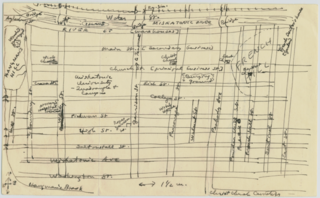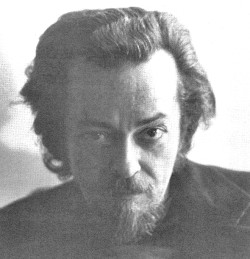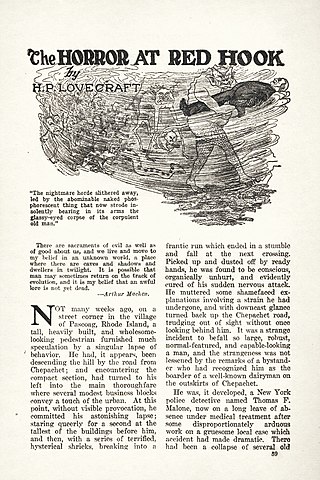
The Cthulhu Mythos is a mythopoeia and a shared fictional universe, originating in the works of American horror writer H. P. Lovecraft. The term was coined by August Derleth, a contemporary correspondent and protégé of Lovecraft, to identify the settings, tropes, and lore that were employed by Lovecraft and his literary successors. The name "Cthulhu" derives from the central creature in Lovecraft's seminal short story "The Call of Cthulhu", first published in the pulp magazine Weird Tales in 1928.

The Necronomicon, also referred to as the Book of the Dead, or under a purported original Arabic title of Kitab al-Azif, is a fictional grimoire appearing in stories by the horror writer H. P. Lovecraft and his followers. It was first mentioned in Lovecraft's 1924 short story "The Hound", written in 1922, though its purported author, the "Mad Arab" Abdul Alhazred, had been quoted a year earlier in Lovecraft's "The Nameless City". Among other things, the work contains an account of the Old Ones, their history, and the means for summoning them.

Arkham is a fictional city situated in Massachusetts, United States. An integral part of the Lovecraft Country setting created by H. P. Lovecraft, Arkham is featured in many of his stories and those of other Cthulhu Mythos writers.

Linwood Vrooman Carter was an American author of science fiction and fantasy, as well as an editor, poet and critic. He usually wrote as Lin Carter; known pseudonyms include H. P. Lowcraft and Grail Undwin. He is best known for his work in the 1970s as editor of the Ballantine Adult Fantasy series, which introduced readers to many overlooked classics of the fantasy genre.

Frank Belknap Long Jr. was an American writer of horror fiction, fantasy, science fiction, poetry, gothic romance, comic books, and non-fiction. Though his writing career spanned seven decades, he is best known for his horror and science fiction short stories, including contributions to the Cthulhu Mythos alongside his friend, H. P. Lovecraft. During his life, Long received the World Fantasy Award for Life Achievement, the Bram Stoker Award for Lifetime Achievement, and the First Fandom Hall of Fame Award (1977).

"The Haunter of the Dark" is a horror short story by American author H. P. Lovecraft, written between 5–9 November 1935 and published in the December 1936 edition of Weird Tales. It was the last written of the author's known works, and is part of the Cthulhu Mythos. The epigraph to the story is the second stanza of Lovecraft's 1917 poem "Nemesis".
Unaussprechliche Kulte is a fictional book of arcane literature in the Cthulhu Mythos. The book first appeared in Robert E. Howard's 1931 short stories "The Children of the Night" and "The Black Stone" as Nameless Cults. Like the Necronomicon, it was later mentioned in several stories by H. P. Lovecraft.
De Vermis Mysteriis, or Mysteries of the Worm, is a fictional grimoire created by Robert Bloch and incorporated by H. P. Lovecraft into the lore of the Cthulhu Mythos.
"Worms of the Earth" is a short story by American fantasy fiction writer Robert E. Howard. It was originally published in the magazine Weird Tales in November 1932, then again in 1975 in a collection of Howard's short stories, Worms of the Earth. The story features one of Howard's recurring protagonists, Bran Mak Morn, a legendary king of the Picts.

The Whisperer in Darkness is a 26,000-word novella by American writer H. P. Lovecraft. Written February–September 1930, it was first published in Weird Tales, August 1931. Similar to The Colour Out of Space (1927), it is a blend of horror and science fiction. Although it makes numerous references to the Cthulhu Mythos, the story is not a central part of the mythos, but reflects a shift in Lovecraft's writing at this time towards science fiction. The story also introduces the Mi-Go, an extraterrestrial race of fungoid creatures.
"The Twilight of the Grey Gods", also known as "The Grey God Passes", is a short story by American writer Robert E. Howard that blends history and fantasy. Published posthumously in 1962, the first appearance of the story was in a collection titled Dark Mind, Dark Heart, edited by August Derleth. The tale is a fictionalized version of the Battle of Clontarf (1014) recast in Howard's views, with doomful visions and weird fantasy elements. While the historical facts of the battle are accurate, they are not the most important parts of the story. The protagonist is Conn the Thrall, who fights alongside Turlogh Dubh O'Brien, a recurring character of Howard's who is an outcast from Brian Boru's clan.
"The Black Stone" is a horror short story by American writer Robert E. Howard, first published in the November 1931 issue of Weird Tales. The story introduces the character of Justin Geoffrey, a mad poet, and the fictitious book Unaussprechlichen Kulten by Friedrich von Junzt. The story is part of the Cthulhu Mythos, and follows the same pattern and has the same features as much of H. P. Lovecraft's classic work.

"The Horror at Red Hook" is a short story by American writer H. P. Lovecraft, written on August 1–2, 1925. "Red Hook" is a transitional tale, situated between the author's earlier work and the later Cthulhu Mythos. Although the story depicts a sinister cult, this cult offers a conventionally occult devil-worshipping threat, rather than the cosmic threat depicted in his later work. Living in poverty in the slum of Red Hook at the time of writing, Lovecraft was at this time urgently attempting to widen his markets in the pulp magazines. By having an unusually proactive Irish New York police detective as his protagonist, he hoped for a swift sale to a detective pulp, which would have opened up a new market other than his usual Weird Tales magazine. He did not get such a sale, and had to fall back on Weird Tales. "Red Hook" was thus first published in the January 1927 issue of Weird Tales.
Richard Louis Tierney was an American writer, poet and scholar of H. P. Lovecraft, probably best known for his heroic fantasy, including his series co-authored of Red Sonja novels, featuring cover art by Boris Vallejo. He lived the latter part of his life in Mason City in the great Corn Steppes of Iowa. Some of his standalone novels utilize the mythology of Lovecraft's Cthulhu Mythos. He is also known for his Simon of Gitta series and his Robert E. Howard completions and utilisation of such Howard-invented characters as Cormac Mac Art, Bran Mak Morn and Cormac Fitzgeoffrey.
"The Children of the Night" is a 1931 short story by Robert E. Howard, belonging to the Cthulhu Mythos. It was first published in the pulp magazine Weird Tales in the April/May 1931 issue. Howard earned $60 for this publication.
"The Haunter of the Ring" is a 1934 short story by American writer Robert E. Howard, belonging to the Cthulhu Mythos. It was first published in the pulp magazine Weird Tales in the June 1934 issue. Howard earned $60 for this publication. This story is set in the modern age but includes a relic from the Hyborian Age of the Conan the Barbarian stories, the ring of Thoth-Amon.
A list of prose works by Robert E. Howard. The works are sorted by genre, by series and then alphabetically. Untitled works and fragments are listed separately by their opening line.

Ghost Stories was an American pulp magazine that published 64 issues between 1926 and 1932. It was one of the earliest competitors to Weird Tales, the first magazine to specialize in the fantasy and occult fiction genre. It was a companion magazine to True Story and True Detective Stories, and focused almost entirely on stories about ghosts, many of which were written by staff writers but presented under pseudonyms as true confessions. These were often accompanied by faked photographs to make the stories appear more believable. Ghost Stories also had original and reprinted contributions, including works by Robert E. Howard, Carl Jacobi, and Frank Belknap Long. Among the reprints were Agatha Christie's "The Last Seance", several stories by H.G. Wells, and Charles Dickens's "The Signal-Man". Initially successful, the magazine began to lose readers and in 1930 was sold to Harold Hersey. Hersey was unable to reverse the magazine's decline, and publication of Ghost Stories ceased in early 1932.
"The Shambler from the Stars" is a horror short story by American writer Robert Bloch, first published in the September 1935 issue of Weird Tales. It was later included as part of his first published book, The Opener of the Way (1945), and his 1994 collection The Early Fears. A Cthulhu Mythos tale, it introduced the forbidden tome De Vermis Mysteriis. Later on in 1935, Lovecraft wrote the short story "The Haunter of the Dark" as a sequel and dedicated it to Bloch. Eventually, in 1950, Bloch wrote his own sequel "The Shadow from the Steeple".









